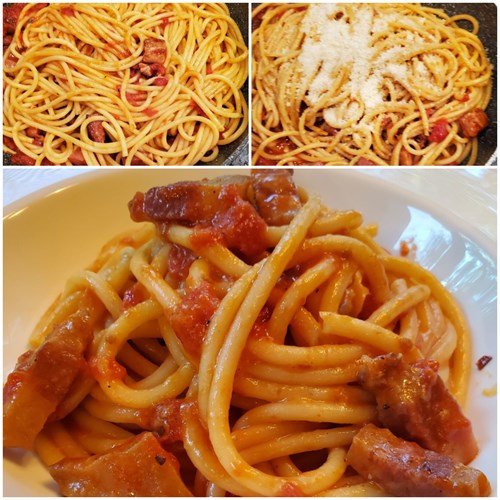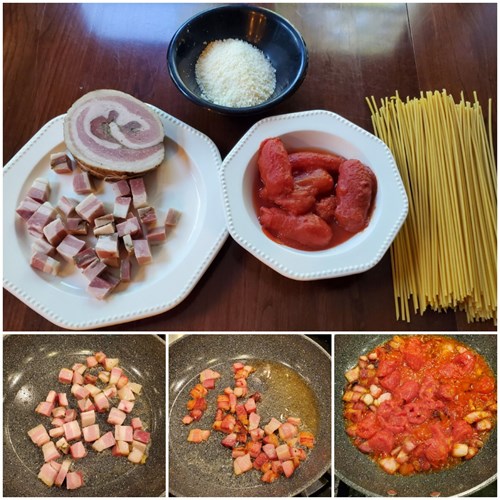Bob's Bucatini All'amatriciana

Bucatini All’Amatriciana is one of the most popular and well-known dishes in Italy and appears on most menus there. It’s said to have originated in the little town of Amatrice near Rieti in the western hills of the Lazio region and dates back at least two hundred years. It’s a descendant of another dish called Pasta All’Gricia, which is basically the same recipe but without tomatoes; it was probably named after Grisciano, also in Lazio. Amatriciana is one of the simplest recipes that I know, with four ingredients: guanciale (pancetta for us), San Marzano tomatoes, bucatini (or spaghetti) and cheese.
The meat of choice for this dish is guanciale, which is pig’s jowl that has been seasoned and dry cured. If you’re ever in a meat market or deli in Italy you’ll see the jowls hanging on the walls or from the ceiling along with prosciutto and other cured meats. The U.S. doesn’t allow importation of guanciale, although I personally imported (smuggled) two of them into Dulles airport a few years ago and sweated bullets as a detection dog sniffed his way from suitcase to suitcase. Fortunately, this wasn’t an Italian dog, and he didn’t know what he was missing. There are a few American producers of guanciale but it is extremely expensive. I buy from Biellese.
Pancetta, which is pork belly, is similarly seasoned and cured, and is sometimes called Italian bacon. (American bacon is not a substitute.) Pancetta is a great substitute for guanciale, and is what we’ll use in this recipe. Pancetta also can’t be imported but is readily available from American producers. I’m sure you can find it at Jungle Jim’s. The pancetta pictured here is from Whole Foods.
Percorino is a name given to any cheese made from sheep’s milk and many regions in Italy have their own versions. The authentic recipe calls for percorino from Amatrice, and isn’t usually available here. The Amatrice Percorino is milder than the Pecorino Romano that is available here and that we’ve used in previous recipes. So, for this recipe we’re using imported Pecorino Romano combined with imported parmesana.
In Italy, pasta sauces are usually identified with particular pastas, for example, Fettucine Alfredo. That is the case with Amatriciana, which in Rome is usually paired with bucatini, a long tubular pasta sometimes called “perciatelli.” Eating bucatini can be an adventure because it is hard to twirl (no cutting, please). Of course, you can also use spaghetti or any other imported pasta.
Ingredients
2 ½-inch thick slices of pancetta, about 5 oz total, trimmed of its rind (but not of its fat) and cut into rectangular pieces about 1 x ½ inches
8-10 oz San Marzano tomatoes, coarsely chopped, LaValle or Cento brand
8-10 oz bucatini (or spaghetti), DeCecco brand
red pepper flakes, optional, to taste
black pepper, to taste
10 oz grated cheese – a mix of 5 oz of imported Pecorino Romano and 5 oz imported parmesana

Put a large pot of water on high heat.
Choose a non-stick skillet (or a well-seasoned stainless one) with a lid that will accommodate the cooked pasta. Heat the skillet without oil on medium-high, then sauté the pancetta until it begins to crisp. (If you tilt the pan you’ll see that the pancetta has shed much of its fat; do not remove this oil as it will flavor the sauce.) Add red pepper flakes, if using. Don’t add salt because both the pancetta and the cheeses contain salt. Add the tomatoes and stir, then cover and cook on very low heat for 20 minutes, stirring occasionally.
Add 1 T salt to the water, bring it to a boil and add the pasta. Add a little black pepper to the sauce and continue to cook for 10 minutes. If at any point the tomatoes seem a bit dry, add a little of the pasta water, remembering that this isn’t a saucy dish. After 10 minutes turn the heat off under the sauce until the pasta is almost done.
When the pasta is al dente (firm to the bite), turn the heat on to medium under the sauce. Drain the pasta then put it directly into the skillet. Toss the pasta in the skillet to thoroughly coat all strands. Turn off the heat under the sauce, add half of the cheese and toss well. Add more cheese, keeping some aside for serving, and toss again. When the ingredients are thoroughly mixed, you can serve directly from the skillet at the table. You’re ready to eat.